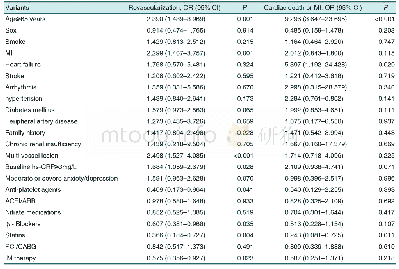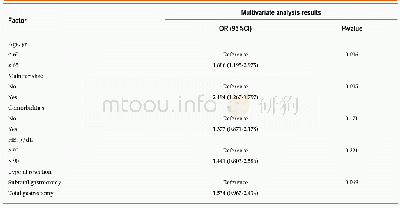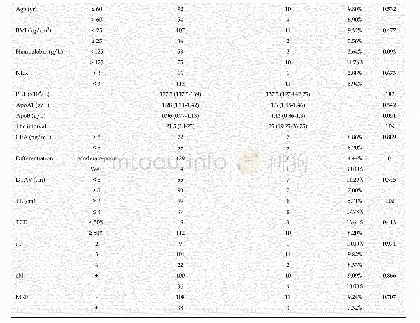《Table 1 Predictive factors for complete pathological response in univariate logistic regression ana
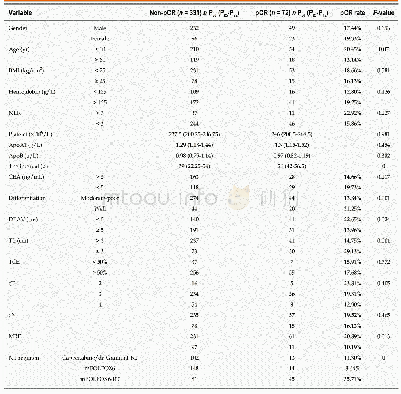 提示:宽带有限、当前游客访问压缩模式
提示:宽带有限、当前游客访问压缩模式
本系列图表出处文件名:随高清版一同展现
《Nomograms for predicting pathological response to neoadjuvant treatments in patients with rectal cancer》
Platelet,apolipoprotein A-1,apolipoprotein B,and the interval were calculated as metrological data,and others are counting data.pCR:Complete pathological response;NLR:Neutrophil-lymphocyte ratio;DTAV:Distance of tumor from the anal verge;TL:Tumor lengt
pCR patients and non-pCR patients did not differ significantly in terms of gender,BMI,CEA,NLR,HB,PLT,ApoA1,ApoB,cT,cN,or TCE in the univariate analysis(P>0.05);however,significant differences were found for age,tumor differentiation,TL,DTAV,MRF status,interval,and NT regimen(Table 1).Statistically significant factors in the univariate logistic regression analysis(P≤0.05)to predict pCR were entered into a multivariate analysis,in which NT regimen types(a P<0.05),tumor differentiation(b P<0.05),TL(c P<0.05),and MRF status(d P<0.05)were significantly associated with pCR probability(Table 2).For the NT regimens,the odds ratio(OR)was 5.339[95%confidence interval(CI):2.394-11.903]for the mFOLFOX6-RT regimen compared with the capecitabine/deGramont-RT regimen.The mFOLFOX6 regimen and capecitabine/deGramont-RT regimen did not differ significantly.For tumor differentiation,the OR was 2.966(95%CI:1.449-6.069)for well tumor differentiation compared with moderate-poor differentiation.For TL(>3 cm)compared with TL(≤3cm),the OR was 2.608(95%CI:1.347-5.052),and for MRF(-)compared with MRF(+),the OR was 2.729(95%CI:1.199-6.211).
| 图表编号 | XD0049330000 严禁用于非法目的 |
|---|---|
| 绘制时间 | 2019.01.07 |
| 作者 | Dong-Lin Ren、Juan Li、Hui-Chuan Yu、Shao-Yong Peng、Wei-Da Lin、Xiao-Lin Wang、Roshan Ara Ghoorun、Yan-Xin Luo |
| 绘制单位 | Department of Colorectal and Anal Surgery,Guangdong Institute of Gastroenterology, Guangdong Provincial Key Laboratory of Colorectal and Pelvic Floor Diseases, The Sixth Affiliated Hospital, Sun Yat-sen University、Department of Colorectal and Anal Surgery |
| 更多格式 | 高清、无水印(增值服务) |
查看“Table 1 Predictive factors for complete pathological response in univariate logistic regression analysis for all patient”的人还看了
-
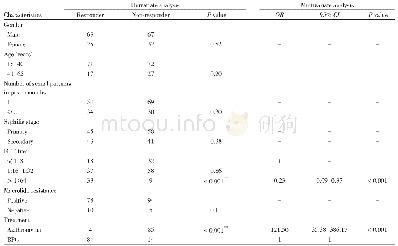
- Table 4 Risk factors associated with serological response for early syphilis patients in the two groups at 12-months fol
-
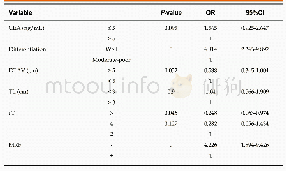
- Table 4 Predictive factors for good downstaging in multivariate logistic regression analysis for all patients

